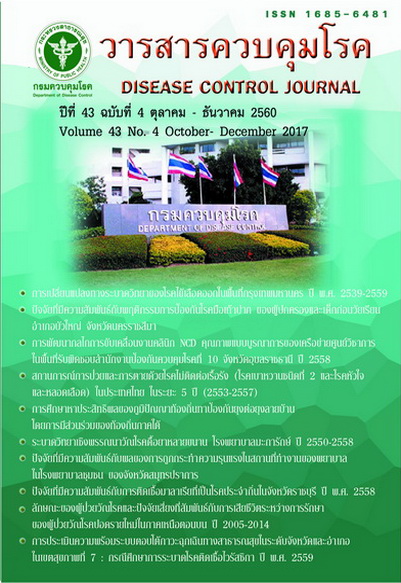Morbidity and mortality situation of non-communicable diseases (diabetes type 2 and cardiovascular diseases) in Thailand during 2010-2014
DOI:
https://doi.org/10.14456/dcj.2017.4Keywords:
non-communicable disease, situation, mortality, morbidity, Thailand, 43 files databasedAbstract
The objectives of this study is to analyze the existing death registration and 43 files services based data to show the mortality and morbidity situation of 4 NCDs in Thailand (diabetes, hypertension, stroke and ischemic heart disease) during 2010-2014 to indicate the target population and issues for NCD prevention and control. This study is a descriptive study by using secondary data of 4 NCDs (diabetes, hypertension, stroke and ischemic heart disease) from (1) the national death registration (2) the 43 files services based of overall service facilities under the Ministry of Public Health (not include Bangkok) during 2010-2014 from the Bureau of Policy and Strategy and (3) the mid-year population data from the National Statistic Office. The data was verified and clean and then analyzed the age-specific, sex-specific morbidity and mortality rate by years and by 12 regions. Findings: the mortality rate and the prevalence of 4 NCDs have been increasing during 2010-2014 both male and female and all over 12 regions with different rates. Those of males in¬creased more rapidly than female; and the rates of people aged 70 and more were highest the premature death (aged 30-69 yrs) of all 4 NCDs increased with the rate of 28.1% in male and 18.8% in female which is higher than the NCD-WHO-targets. The increasing rate of mortality and morbidity was also observed in the younger population. The prevalence of diabetes and hypertension from this data based was found higher in female than male. But the ischemic heart disease and stroke was found in male higher than male. The situa¬tions was also different among health regions in Thailand. Conclusion and recommendations: the situation of 4 NCDs showed the serious situation of NCD in Thailand that need the more specific and more effective diseases prevention and control especially for the male and the working age population
Downloads
References
2. สำนักงานพัฒนานโยบายสุขภาพระหว่างประเทศ. รายงานภาระโรคและการบาดเจ็บของประชากรไทย พ.ศ. 2556. นนทบุรี: สำนักงานพัฒนานโยบาย สุขภาพระหว่างประเทศ; 2557.
3. Bloom DE, Cafiero E, Jane-Lolpis E, Abrshams-Gessel S, Bloom LR. The global economic burden of non-communicable diseases. Geneva: World Economic Forum; 2011.
4. World Health Organization. World Health As¬sembly: global strategy for the prevention and control of non-communicable diseases. Geneva: World Health Assembly; 2000.
5. World Health Organization. Global action plan for the prevention and control of non-communi¬cable diseases 2013-2020. Geneva: World Health Organization; 2013.
6. สำนักงานพัฒนานโยบายสุขภาพระหว่างประเทศ. รายงานสถานการณ์โรค NCDs วิกฤตสุขภาพ วิกฤต สังคม. นนทบุรี: สำนักงานพัฒนานโยบายสุขภาพ ระหว่างประเทศ; 2557.
7. เยาวรัตน์ ปรปักษ์ขาม. โครงการพัฒนาคุณภาพ สาเหตุการตายในประเทศไทย พ.ศ. 2548-2551 (setting priorities using information on cost-effectiveness: SPICE 2004-2009). กรุงเทพ มหานคร: จรัลสนิทวงศ์การพิมพ์; 2552.
8. อรรถเกียรติ กาญจนพิบูลวงศ์, สุพัตรา ศรีวณิชชา กร. สถานการณ์โรคไม่ติดต่อ ปัจจัยเสี่ยงต่อโรคไม่ ติดต่อ และการจัดระบบบริการ เพื่อตอบสนองต่อ โรคไม่ติดต่อตามเป้าหมาย และตัวชี้วัดระดับโลก ของประเทศไทย ปี พ.ศ. 2553-2558. นนทบุรี: สหมิตร พริ้นติ้ง แอนด์ พับลิชชิ่ง; 2559.
9. ภัทระ แสนไชยสุริยา, ภูษิต ประคองสาย, ปาริชาติ จันทร์จรัส, กุมารี พัชนี, อุมาพร อุดมทรัพยากุล, บังอร เทพเทียน.รายงานประเมินแผนงานควบคุม โรคไม่ติดต่อในประเทศไทย ปีงบประมาณ 2553- 2557. กรุงเทพมหานคร: คณะสาธารณสุขศาสตร์ มหาวิทยาลัยมหิดล; 2559.
10. เยาวรัตน์ ปรปักษ์ขาม, พรพันธุ์ บุญยรัตพันธุ์. การสำรวจสภาวะสุขภาพอนามัยของประชาชนไทย ครั้งที่ 3. กรุงเทพมหานคร: องค์การสงเคราะห์ ทหารผ่านศึกในพระบรมราชูปถัมภ์; 2549.
11. วิชัย เอกพลากร, เยาวรัตน์ ปรปักษ์ขาม, สุรศักดิ์ ฐานีพานิชสกุล, หทัยชนก พรรคเจริญ, วราภรณ์ เสถียรนพเก้า, กนิษฐา ไทยกล้า. การสำรวจสุขภาพ ประชาชนไทยโดยการตรวจร่ายกาย ครั้งที่ 4 พ.ศ. 2551-2552. นนทบุรี: เดอะกราฟิโก ซิสเต็มส์; 2553.
Downloads
Published
How to Cite
Issue
Section
License
Articles published in the Disease Control Journal are considered as academic work, research or analysis of the personal opinion of the authors, not the opinion of the Thailand Department of Disease Control or editorial team. The authors must be responsible for their articles.






